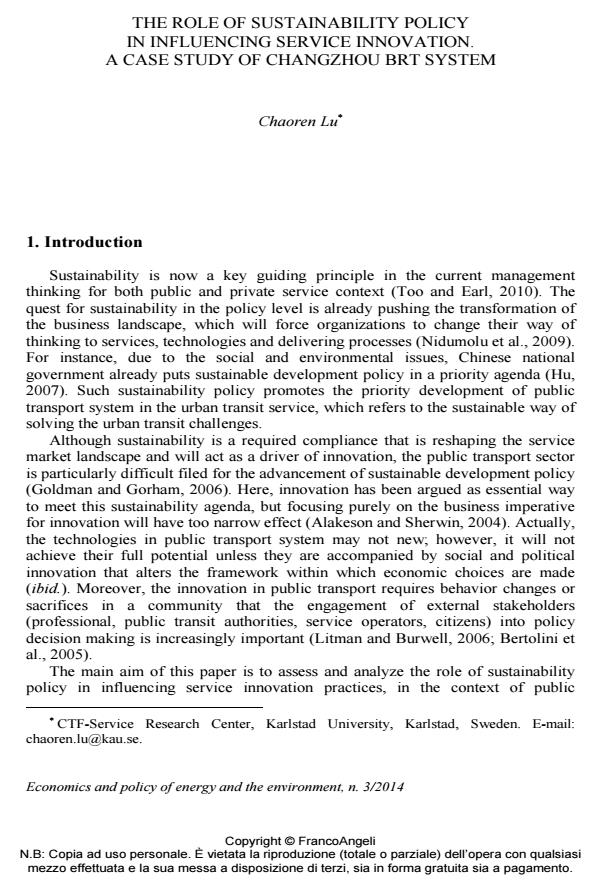The role of sustainability policy in influencing service innovation. a case study of Changzhou BRT system
Journal title ECONOMICS AND POLICY OF ENERGY AND THE ENVIRONMENT
Author/s Chaoren Lu
Publishing Year 2015 Issue 2014/3
Language English Pages 12 P. 167-168 File size 681 KB
DOI 10.3280/EFE2014-003009
DOI is like a bar code for intellectual property: to have more infomation
click here
Below, you can see the article first page
If you want to buy this article in PDF format, you can do it, following the instructions to buy download credits

FrancoAngeli is member of Publishers International Linking Association, Inc (PILA), a not-for-profit association which run the CrossRef service enabling links to and from online scholarly content.
Purpose. The main aim of this paper is to assess and analyze the role of sustainability policy in influencing service innovation practices in the context of public transport. The intension is to understand the critical dimensions related to sustainability policy driven service innovation. The critical dimensions mainly focus on the relationship between innovation and policy, the challenges, competences and opportunities driven by sustainability policy. Design/methodology/approach. The paper is of an explorative nature. Critical case study method is adopted in this paper to understand the role of sustainability policy in service innovation. Findings. The study reveals that national sustainability policy framework drives the formulation and implementation of sustainable service innovation as a tool to achieve sustainable public transit system. The sustainability policy context in terms of responsibility, power and resource integration creates shared-platform that induces service innovation, which create value co-creation opportunities to the customers and other stakeholders. Research limitations/implications. The single case-study design of the present research does not enable empirical generalizations to be made. Contribution/value. The paper makes an original contribution to the study of sustainable and innovative public transit by explicitly linking the adoption of sustainability policy and its role in service innovation and value co-creation embedded on social and environmental perspectives. Practical implications. National policies often cannot influence local/urban transport directly, but become effective tool towards service innovation and value co-creation.
Keywords: Sustainable public transit, sustainability policy, service innovation, value cocreation, bus rapid transit
Jel codes: L88
- Developing sustainable business-to-business (B2B) strategies in service innovation for enhancing customer loyalty in the petrochemical industry: a systematic review Oos Kosasih, Kadarisman Hidayat, Benny Hutahayan, Sunarti, in Cogent Business & Management 2422564/2024
DOI: 10.1080/23311975.2024.2422564 - Assessing the impact of transition from nonrenewable to renewable energy consumption on economic growth-environmental nexus from developing Asian economies Muhammad Mohsin, Hafiz Waqas Kamran, Muhammad Atif Nawaz, Muhammed Sajjad Hussain, Abdul Samad Dahri, in Journal of Environmental Management 111999/2021 pp.111999
DOI: 10.1016/j.jenvman.2021.111999
Chaoren Lu, The role of sustainability policy in influencing service innovation. a case study of Changzhou BRT system in "ECONOMICS AND POLICY OF ENERGY AND THE ENVIRONMENT" 3/2014, pp 167-168, DOI: 10.3280/EFE2014-003009